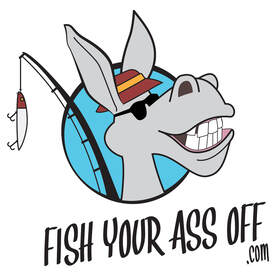
What is the best flounder/fluke rig?
The answer is two white Gulp swimming mullet tied on the same line as tandem jigs. The jig on the bottom should be heavier than the jig that is tied 10 to 12 inches higher on the line. The bottom jig head can be 1/8 ounce up to 1 ounce depending upon how deep you are fishing.
This flounder/fluke rig is by far the best for catching flounder regardless of what part of the country you are fishing for them. The bottom jig holds the tandem jig set within the 12 to 18 inch from the bottom strike zone of the fish. The top jig stays above of the sand, mud and gravel which is why it gets most of the hook ups.
You really do not need to know any other flounder fishing rigs than this one and you really don't need different colors either. White and chartreuse are the only combinations that you will ever need for flounder and fluke fishing.
A white Berkeley Gulp swimming mullet or 5 inch jerk bait with a chartreuse jig head is all that you really need to catch a ton of flounder and flukes. You can mix and match to see which one gets the most hits.
The key is to keep your baits within a foot or so of the bottom when you raise your rod tip to give the tandem rig its action. Flounder and flukes like their food to be very close to the bottom.
* I am not sponsored by Berkeley Gulp or any other lure company that I mention in my articles.
I am a FISHING CHARTER CAPTAIN on the Treasure Coast of Florida. I have been fishing the docks, sand bars, grass flats and mangroves all over Florida for more than 40 years. Flounder, snook, tarpon, redfish and speckled trout are my target species most of the time.
In the article below, I will teach you what you need to know to catch many flounder and fluke with the tandem rig set up.
Watch the video below and learn more about the tandem rig for flounder and fluke fishing.
The answer is two white Gulp swimming mullet tied on the same line as tandem jigs. The jig on the bottom should be heavier than the jig that is tied 10 to 12 inches higher on the line. The bottom jig head can be 1/8 ounce up to 1 ounce depending upon how deep you are fishing.
This flounder/fluke rig is by far the best for catching flounder regardless of what part of the country you are fishing for them. The bottom jig holds the tandem jig set within the 12 to 18 inch from the bottom strike zone of the fish. The top jig stays above of the sand, mud and gravel which is why it gets most of the hook ups.
You really do not need to know any other flounder fishing rigs than this one and you really don't need different colors either. White and chartreuse are the only combinations that you will ever need for flounder and fluke fishing.
A white Berkeley Gulp swimming mullet or 5 inch jerk bait with a chartreuse jig head is all that you really need to catch a ton of flounder and flukes. You can mix and match to see which one gets the most hits.
The key is to keep your baits within a foot or so of the bottom when you raise your rod tip to give the tandem rig its action. Flounder and flukes like their food to be very close to the bottom.
* I am not sponsored by Berkeley Gulp or any other lure company that I mention in my articles.
I am a FISHING CHARTER CAPTAIN on the Treasure Coast of Florida. I have been fishing the docks, sand bars, grass flats and mangroves all over Florida for more than 40 years. Flounder, snook, tarpon, redfish and speckled trout are my target species most of the time.
In the article below, I will teach you what you need to know to catch many flounder and fluke with the tandem rig set up.
Watch the video below and learn more about the tandem rig for flounder and fluke fishing.
Where is the best place to catch fluke an flounder with a tandem rig?
You can find flounder inshore for most of the year but most of them do leave the shallows and head into the Atlantic Ocean and Gulf of Mexico to spawn in the winter months. So it is harder to find any decent sized flounder inshore during those months.
They move back inshore in the spring and stay until the following winter. This gives inshore flounder/fluke fishermen plenty of opportunities to catch some.
These fish gravitate towards structure. This structure can be a pot hole in a sand bar or grass flat; It can be an oyster bar in a tidal creek; It can be the pilings of a dock or bridge; It can be a reef off of the beach. It can be the mangrove roots during high tide. In other words, you will want to use your tandem flounder rig near structure of some sort to maximize your results.
The key to fishing this rig is your retrieve. Fluke are much more aggressive than flounders. They will leave their hiding places and chase your tandem rig from afar and attack it. For the most part, a flounder will only leave its hiding place for your tandem rig if it comes within a couple feet of where it is hiding.
I created a FREE online flounder fishing course all about the best baits, lures, tackle, tips and techniques to catch more flounder. You can see that fishing course on this website by clicking right here.
When you find a likely spot holding fish make sure to fan cast the area to get your tandem rig within 3 feet or so of the last cast until you cover the entire area. Keep doing that and go find another spot if you don't get any hits.
If you do get a flounder or fluke, then stay put for a while because they are never alone. You will often catch 5 or 6 in the same area.
Flounder and fluke prefer fish over crabs and shrimp so the bigger lure profiles typically work better for your tandem rigs. You can use 3 inch Berkeley Gulp shrimp but the 4 inch shrimp tend to get more bites. Keep this in mind if you decide to use other baits than Gulp.
Gulp baits are expensive lures and you can go through them quickly when you are catch a lot of different species with sharp teeth like blue fish. They will hit this rig too.
You can use 5 or 6 inch jerk baits and curly tails if you decide to go with a different tandem lure set up but the Gulps seem to work the best but like I said earlier, they are pricey.
WANT TO CATCH FLOUNDER? BOOK YOUR FISHING CHARTER TODAY!
Watch the video below to see some wade fishing for flounder action.
Conclusion:
The bottom line when it comes to catching flukes and flounder or any other flat fish for that matter, tandem rigs work the best. It is really that simple. Those types of fish spend their lives hidden in the sand or gravel waiting for some unsuspecting prey item to swim too close to them.
The Gulp tandem rig works so well at getting their attention and triggering an attack. They put out a ton of odor molecules in the water and the erratic action of the top jig will put out those low frequency vibrations that predatory fish like so much. Once the tandem rig gets close enough the flukes and flounders can't keep themselves from attacking it.
I hope that this article helps you catch many more flounders and flukes or at the very least let's you have more fun trying. Thanks for reading it.
Do you like how to fishing articles like this one? If you answered yes, then sign up for our email list below because we will send you a new article every week. Sign up now and get your first one today.
